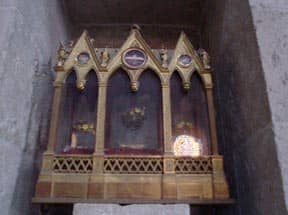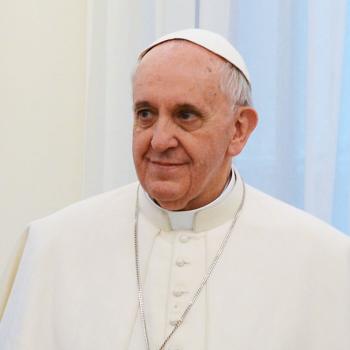By Cynthia Stewart

 "Is that her real head?" exclaimed the Protestant friends with whom I was investigating the Church of San Dominico in Siena. Yes indeed, it was the mummified head of 14th-century uber-saint Catherine of Siena, all wrapped up in a nun's wimple. It was what we had come to see, but somehow my Protestant friends hadn't actually expected to see it. A container holding the head, maybe, or a funereal mask, but a real mummified head was freaking them out.
"Is that her real head?" exclaimed the Protestant friends with whom I was investigating the Church of San Dominico in Siena. Yes indeed, it was the mummified head of 14th-century uber-saint Catherine of Siena, all wrapped up in a nun's wimple. It was what we had come to see, but somehow my Protestant friends hadn't actually expected to see it. A container holding the head, maybe, or a funereal mask, but a real mummified head was freaking them out.
Accustomed in my Catholic way to the idea of relics and the body parts of saints reverenced and on display, I was able to give them a short introduction to relics and their importance in the Catholic world. And important they are, as you may know if you've ever prayed before an altar in a Catholic church. More on that later.
Holy Remains
In Catholic understanding, relics are the bodily remains of saints and martyrs or articles that touched their bodies, plus anything that ever came anywhere in the vicinity of Jesus or Mary. The idea is that these people had so much holiness flowing through them that some of it stuck around on their remains and such after their death, and that the power inherent in the relics can bring about miracles large and small. Basically relics and prayers to saints are byproducts of the same belief that the saints have joined God in heaven and can intercede for people on earth, even being given power by God to do good for people.
Christians didn't get their reverence for relics by looking to their Jewish brethren. In Jewish law, touching the body of a dead person makes you ritually unclean, and this applies even if the dead person is worthy and righteous and otherwise an all-around good guy. From really early on, like the 2nd century, Christians went totally in the opposite direction, wanting to touch their worthy dead in order to get a dose of all that holiness. This was especially true of those killed for their faith. We hear about people carting off the parts of St. Ignatius of Antioch that were left after his grisly demise in the arena, and then of the bones of other martyrs being carried away from the sites of their executions.
Spreading the Holiness Around
At first the remains of saints and martyrs were placed in coffins or tombs; so much reverence was shown for the relics that it seemed natural to celebrate the Eucharist there, and churches grew up around them. Within a couple of centuries, though, people started seeing the benefit of carving up those saints so all that holiness could be shared around. If fervently praying before the body of a saint can lead to a miracle, then wouldn't it be better if more people had the chance to see and pray before those remains? An intact body can only be in one place, but when you send various parts to various places, lots more people can have access to that holiness.
Relic mania got wacky and out of hand in the Middle Ages, with pieces of the True Cross turning up everywhere, Mary's girdle making its way to Syria, multiple heads of Mary Magdalene lying about, and various other lunacies. The Crusades did a lot for the relic trade, with Crusaders returning from their travels with real or false relics of all kinds; Christian Europe was inundated with pieces of this and articles of that saint. The Reformation, and the Enlightenment close on its heels, put a stop to a lot of that, a fact that has allowed relics to regain their original place once more, as reminders of grace rather than purveyors of magic.
Relics in Your Very Own Church
Even though Catholics accept relics as part and parcel of the cultural context of their faith, many don't realize that the altars in most Catholic churches contain the relics of a saint. In fact, it used to be mandatory for altars to contain relics, but that requirement was relaxed in the 1960s. Still, in the vast majority of Catholic churches worldwide you'll find embedded in the altar an altar stone, a slab into which one or more relics have been placed. Just as early Christians came together to worship over the bones of their revered dead, so to do modern Catholics, albeit not always knowingly.
But sometimes you can't miss the relic, because sometimes a finger or a leg bone or even a head surrounded by a nun's wimple is right out there on display for all to see.
Read earlier installments of "Catholics Do This but Don't Do That":




